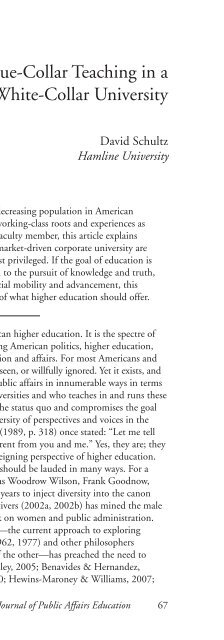WINTER 2012 - National Association of Schools of Public Affairs and ...
WINTER 2012 - National Association of Schools of Public Affairs and ...
WINTER 2012 - National Association of Schools of Public Affairs and ...
Create successful ePaper yourself
Turn your PDF publications into a flip-book with our unique Google optimized e-Paper software.
Exploring Academic <strong>and</strong> Social Networks<br />
the pattern <strong>of</strong> interactions for one network align with that <strong>of</strong> interactions for<br />
another network? In the following sections, we first review the literature on<br />
network development through pr<strong>of</strong>essional degree programs <strong>and</strong> then focus<br />
our discussion on identifying four types <strong>of</strong> networks—academic, career advice,<br />
friendship, <strong>and</strong> socio-emotional support formed among Chinese MPA students.<br />
After describing the data collection <strong>and</strong> research method, we present our<br />
findings; <strong>and</strong> we conclude by providing directions for future research.<br />
BUILDING NETWORKS THROUGH PROFESSIONAL GRADUATE DEGREE PROGRAMS<br />
A key starting point <strong>of</strong> exploring network building through pr<strong>of</strong>essional<br />
graduate studies involves the social <strong>and</strong> psychological foundations <strong>of</strong> human<br />
desire for connecting with others. In Maslow’s well-known but controversial<br />
theory <strong>of</strong> hierarchy <strong>of</strong> human needs, social needs at level 3 refer to the needs<br />
for love, affection, <strong>and</strong> belonging to social units <strong>and</strong> groups (Maslow, 1954).<br />
In his theory <strong>of</strong> human needs, McClell<strong>and</strong> (1961) pointed to the human need<br />
for affiliation—the need to establish <strong>and</strong> maintain positive affective relations<br />
or friendship with others. Similarly, Herzberg (1968) included quality <strong>of</strong><br />
interpersonal relations among peers, with supervisors, <strong>and</strong> with subordinates as<br />
one <strong>of</strong> the factors to motivate people.<br />
The recent stream <strong>of</strong> research on social capital adds a new perspective on the<br />
development <strong>of</strong> social networks through a pr<strong>of</strong>essional master’s degree program.<br />
Social scientists have long used notions <strong>of</strong> capital (e.g., human capital, cultural<br />
capital, <strong>and</strong> social capital) as organizing concepts to underst<strong>and</strong> the mechanisms<br />
that affect life chances <strong>of</strong> individuals <strong>and</strong> the well-being <strong>of</strong> communities. Pr<strong>of</strong>essional<br />
master’s degree programs, such as an MBA or MPA, can increase scholastic,<br />
cultural, <strong>and</strong> social capital for students (Baruch, Bell, & Gray, 2005; Useem<br />
& Karabel, 1986). Students who are enrolled in an MPA degree program develop<br />
their scholastic capital through acquiring managerial knowledge that is essential<br />
for them to function effectively in public <strong>and</strong> nonpr<strong>of</strong>it organizations. These<br />
programs provide students with explicit, theoretical knowledge as well as tacit<br />
analytical skills, such as analyzing cases. Cultural capital refers to the value <strong>of</strong><br />
reputation that people within a society attach to a prestigious graduate degree. As a<br />
symbol <strong>of</strong> status, cultural capital helps individuals climb the social status ladder.<br />
Aside from scholastic <strong>and</strong> cultural capital, students can also benefit from<br />
attaining a pr<strong>of</strong>essional graduate degree by acquiring social capital embedded<br />
in their social networks. Social networks are a set <strong>of</strong> relationships with stable<br />
patterns <strong>of</strong> repeated interactions. Lin (2000, p. 786) defined social capital as<br />
investment <strong>and</strong> use <strong>of</strong> embedded resources in social relations for expected<br />
returns. Social capital is conceptualized as (1) quantity <strong>and</strong>/or quality <strong>of</strong><br />
resources that an actor (be it an individual or group or community) can<br />
access or use through (2) its location in a social network.<br />
Journal <strong>of</strong> <strong>Public</strong> <strong>Affairs</strong> Education 139

















